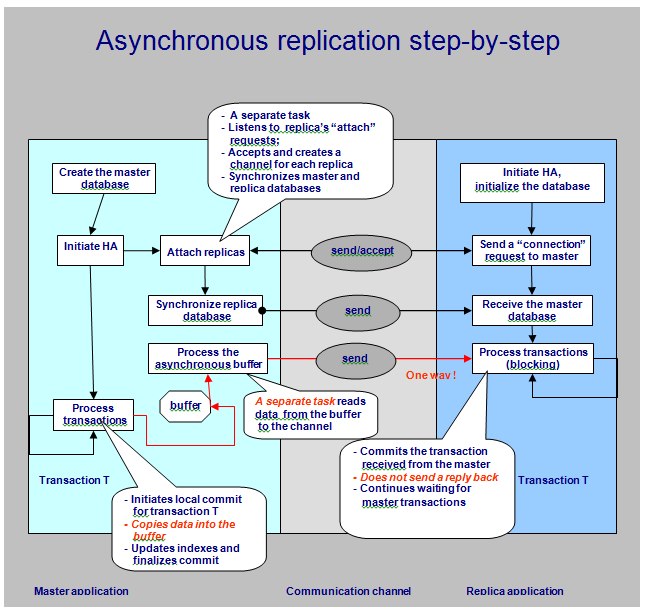Asynchronous Replication
As mentioned in the HA Applications page, in
asynchronousor lazy replication, updates are propagated to replica nodes asynchronously and after the transaction commits on the master node. These updates are applied to replica nodes as separate transactions which can improve transaction responsiveness, however replicaread-onlytransactions run the risk of operating with stale data. Because replica databases are available to the replica applications for read-only access, replica applications may read ‘stale’ data if transactions were committed at the master but not yet propagated to the replica.Asynchronous replication is enabled in C/C++ applications by setting the
mode_flagselement toMCO_HAMODE_ASYNCHin the master:mco_HA_master_params_t MasterParams; mco_HA_master_params_init( &MasterParams ); MasterParams.mode_flags = MCO_MASTER_MODE | MCO_HAMODE_ASYNCH; … mco_HA_set_master_params( db, &MasterParams );In C# and Java applications:
MasterConnection.Parameters MParams = new MasterConnection.Parameters( MasterConnection.MCO_HAMODE_ASYNCH); con.SetReplicationMode( MParams );The master application must also create a memory device to accommodate the asynchronous buffer in either shared or conventional memory. The size of the buffer is defined in bytes (not in a number of transactions) and is processed in a separate task within the eXtremeDB High Availability runtime.
The following code snippet demonstrates how the async buffer can be initialized in C/C++ applications:
/**************************************************** * Asynchronous commit thread * It sends transaction data to replicas using the async_databuf ****************************************************/ void AsyncCommit( sample_task_t * descriptor ) { /* wait for async commit event and output the portion of data to the stream */ while (mco_HA_async_send_data_to_replicas(descriptor->db_connection) == MCO_S_OK) sample_sleep(1); } /**************************************************** /* Snippet from the master main that initializes async replication */ /**************************************************** mco_HA_master_params_init( &MasterParams ); MasterParams.mode_flags = MCO_MASTER_MODE | MCO_HAMODE_ASYNCH; /* assign the device as an asynchronous buffer */ MasterParams.async_databuf.assignment = MCO_MEMORY_ASSIGN_HA_ASYNC_BUF; /* set the device size */ MasterParams.async_databuf.size = ASYNC_DATABUF_SIZE; if ( runtime_info.mco_shm_supported ) { /* set the device as a shared named memory device */ MasterParams.async_databuf.type = MCO_MEMORY_NAMED; /* set memory name */ sprintf( MasterParams.async_databuf.dev.named.name, "%s-ha", db_name); MasterParams.async_databuf.dev.named.flags = 0; /* zero flags */ /* set mapping address or zero it out */ MasterParams.async_databuf.dev.named.hint = 0; } else { /* set a conventional memory device */ MasterParams.async_databuf.type = MCO_MEMORY_CONV; MasterParams.async_databuf.dev.conv.ptr = (void*)malloc(ASYNC_DATABUF_SIZE); } mco_HA_set_master_params(db, &MasterParams); /* set MASTER mode */ /* start the ListenToReplicas thread*/ sample_start_connected_task(&listen_task, ListenToReplicas, db_name, &ha ); /* start the AsyncCommit thread*/ sample_start_connected_task(&async_commit_task, AsyncCommit, db_name, 0 );A similar C# implementation would look like the following:
// Asynchronous commit thread that sends transaction data to replicas, // using async databuf public void Replicate() { MasterConnection con = new MasterConnection(db); while (con.AsyncSendDataToReplicas()) { Thread.Sleep(REPLICATION_PERIOD); } con.Disconnect(); } Master() { //**************************************************** // Snippet from the master main that initializes async replication //**************************************************** // set HA mode MasterConnection.Parameters MParams = new MasterConnection.Parameters( MasterConnection.MCO_HAMODE_ASYNCH ); MasterParams.AsyncBuf = new Database.PrivateMemoryDevice( Database.Device.Kind.AsyncBuffer, ASYNC_BUF_SIZE ); con.SetReplicationMode( MParams ); MParams.listening = true; // start listen and async. commit threads Thread listenThread = new Thread(new ThreadStart(Listen)); Thread replicateThread = new Thread(new ThreadStart(Replicate)); listenThread.Start(); replicateThread.Start();As with synchronous replication, no additional replication logic is required in either master or replica applications; all replication operations are managed internally by the eXtremeDB High Availability runtime.

Replication Event Notifications
Whether using
synchronousorasynchronousreplication, replica application instances can be configured to receive notification of various synchronization and replication events. The possible notification events are defined as follows:MCO_REPL_NOTIFY_CONNECTEDReplica successfully connected.MCO_REPL_NOTIFY_CONNECT_FAILEDReplica connection failed.MCO_REPL_NOTIFY_DB_EQUALThe database is the same, no need to load the database.MCO_REPL_NOTIFY_DB_LOAD_BEGINBegin loading the database.MCO_REPL_NOTIFY_DB_LOAD_FAILEDError loading the database; param1 on the notification callback is the MCO_RET return code.MCO_REPL_NOTIFY_DB_LOAD_OKDatabase successfully loaded; param1 on the notification callback is the MCO_E_HA_REPLICA_STOP_REASON code.MCO_REPL_NOTIFY_DB_CREATION_FAILEDDatabase creation failed" notification; param1 on the notification callback is the MCO_RET return code.MCO_REPL_NOTIFY_COMMIT_FAILEDError during a transaction commit; param1 on the notification callback is the MCO_RET return code.MCO_REPL_NOTIFY_REPLICA_STOPPEDReplication stopped.MCO_REPL_NOTIFY_HOTSYNCHotsynch process beginning.MCO_REPL_NOTIFY_EOHOTSYNCHotsynch process completed.MCO_REPL_NOTIFY_STATEFUL_SYNCStateful synch process beginning.MCO_REPL_NOTIFY_STATEFUL_SYNC_ENDStateful synch process completed.MCO_REPL_NOTIFY_MASTER_DB_EXTENDEDThe master has extended the database memory.Replication event notifications in C/C++ replica applications are enabled by setting the
MCO_HAMODE_REPLICA_NOTIFICATIONbit in themode_flagselement and the function address of the event handler in thenotifying_callbackelement in themco_HA_replica_params_tstructure passed tomco_HA_attach_master(). In C# and Java applications the mode flag and callback are specified in theReplicaConnection.Parameterssent to methodReplicaConnection.AttachMaster().